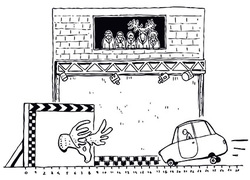
SWOT stands for Strengths, Weaknesses, Opportunities and Threats.
SWOT analysis is often used for analysing the strengths, weaknesses, opportunities and threats in an operation, as part of strategy work. This method is also applicable to a number of areas in municipalities/organisations, e.g. to acquire the citizens’ views on plans, projects, commissions, etc.
The analysis model is usually pictured as a matrix with four squares which provides an overview of the most important factors to regard when analysing an operation, a project, plans, etc.
A suitable way of utilising the SWOT analysis could be the following:
The results of the SWOT analysis are compiled to comprise a basis for the continued process. Clarity about the aim of the meeting and that a specific method – SWOT analysis - will be used is important. Select a process leader who is familiar with the method. Arrange the premises so the walls have space for putting notes with the different factors under respective headings in the matrix. Post-it notes could be used favourably. It is also possible to use just the two upper squares in the matrix; which strengths and weaknesses are there? It quickly exposes the strengths and weaknesses, threats and opportunities that could affect the operation/subject/issue. This is a good tool for finding out where to put the efforts in an issue. The strengths you identify should of course be attended to in the future. The weaknesses you identify, you should consider how to treat. The threats you see, you must try to remove completely from e.g. the operation, and finally, the opportunities you see you should strive to utilise and develop.
SWOT analysis is often used for analysing the strengths, weaknesses, opportunities and threats in an operation, as part of strategy work. This method is also applicable to a number of areas in municipalities/organisations, e.g. to acquire the citizens’ views on plans, projects, commissions, etc.
The analysis model is usually pictured as a matrix with four squares which provides an overview of the most important factors to regard when analysing an operation, a project, plans, etc.
A suitable way of utilising the SWOT analysis could be the following:
- Brainstorming, i.e. all participants bring up as many different factors as they can think of, that could affect the operation/issue/subject ahead.
- Place all the factors in the matrix jointly.
- Evaluation of the factors on a 1-5 scale: 5 means either very good (strengths and opportunities) or very bad (weaknesses and threats).
- Ranging according to the evaluation scale in all four areas.
- Proposed measures:
- How to use strengths
- How to get over weaknesses
- How to take advantage of opportunities
- How to avoid/fend off threats
The results of the SWOT analysis are compiled to comprise a basis for the continued process. Clarity about the aim of the meeting and that a specific method – SWOT analysis - will be used is important. Select a process leader who is familiar with the method. Arrange the premises so the walls have space for putting notes with the different factors under respective headings in the matrix. Post-it notes could be used favourably. It is also possible to use just the two upper squares in the matrix; which strengths and weaknesses are there? It quickly exposes the strengths and weaknesses, threats and opportunities that could affect the operation/subject/issue. This is a good tool for finding out where to put the efforts in an issue. The strengths you identify should of course be attended to in the future. The weaknesses you identify, you should consider how to treat. The threats you see, you must try to remove completely from e.g. the operation, and finally, the opportunities you see you should strive to utilise and develop.
 RSS Feed
RSS Feed
